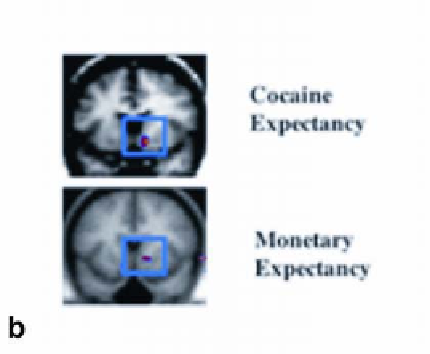Biomedical Engineering Reference
In-Depth Information
Figure 7b
. Overlap in NAc for expectancy responses. Expectancy of a cocaine infusion is shown in the upper
panel from a study of double-blind, randomized, cocaine vs. saline infusions in cocaine dependent subjects
(37,33). Expectancy of a monetary gain is shown in the lower panel from a study involving a game of chance
in healthy controls (38). Note the close anatomic proximity for NAc signal changes during positive expec-
tancy in the context of uncertainty for both experiments. Results are shown in the radiological orientation as
pseudocolor statistical maps juxtaposed on coronal group structural images in gray tone.
monetary reward have significantly extended these observations of differential
expectancy responses in some reward regions (137) and differential outcome
effects (88). Other important studies with categorical rewards have shown seg-
regation of expectancy and outcome effects, without counterfactual comparison
effects (24,189). There appears to be a concordance of findings between differ-
ent research groups, and overlap across studies within the same research group
(e.g., such as similar expectancy findings in the NAc) for a monetary stimulus
(38) and, retrospectively, for a cocaine infusion (33) (Figure 7b). This argues
that different categories of reward are evaluated by a distributed set of reward
regions, which can be functionally dissected.
Complementing the monetary reward studies, the study of social stimuli in
the form of beautiful versus average faces addressed the issue of valuation and
relative preference (see Figure 3). Incorporating a keypress paradigm, this study
objectively quantified the reinforcement value of each stimulus by measuring
the effort that experimental subjects expended to increase or decrease their
viewing time of each face relative to a default viewing time (Figure 8a). For this
procedure quantifying relative preferences, these face stimuli could be consid-
ered to be items in an economic bag of goods. The output of this keypress pro-
cedure was a representation of the utility function for each individual toward this
set of items (Figure 8b). The results of this study argued that judgements of rela-
tive preference or utility were related to activity in a subset of reward regions.


